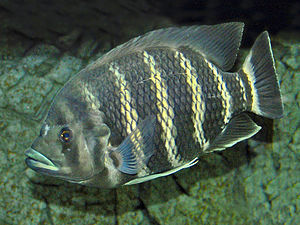Zebra tilapia
| Zebra tilapia | ||||||||||||
|---|---|---|---|---|---|---|---|---|---|---|---|---|

Zebra tilapia ( Heterotilapia buttikoferi ) |
||||||||||||
| Systematics | ||||||||||||
|
||||||||||||
| Scientific name | ||||||||||||
| Heterotilapia buttikoferi | ||||||||||||
| ( Hubrecht , 1881) |
The zebra tilapia ( Heterotilapia buttikoferi ) is a species of fish from the cichlid family (Cichlidae) that occurs in West Africa from Guinea-Bissau to Guinea , Sierra Leone to western Liberia .
features
The fish species can reach a length of 30 to 40 cm. Females stay significantly smaller than males. The zebra tilapia is very high back and strongly flattened on the sides. The head profile is clearly concave. The basic color of the fish is whitish-gray to whitish-yellow; on the sides of the body they show eight black to dark brown horizontal stripes, which are wider than the light zone between them. The first of these stripes goes through the eye, the last is on the tail stalk. The tail fin base is light, the middle and end are dark. The rear edge of the caudal fin is again light. The pelvic fins, which are long drawn out in adult animals, are dark with a light front edge. The pectoral fins are transparent. The lips of the fish are light blue. In adult males, the back may have a slightly bronze shimmer. Very large zebra tilapias can also be a solid dark gray to blackish color. Young fish show a tilapia spot in the front section of the dorsal fin . The lower pharyngealia is as long as it is wide, and the anterior section is shorter than the dentate area. The central fangs are wider than the lateral ones.
- Fin formula : Dorsal XIII – XV / 14–16, Anale III / 10–11.
- Dandruff formula 19–22 / 9–13 (SL), 29–32 (mLR)
Way of life
The zebra tilapa occurs in larger West African rivers, e.g. B. in the Geba in the Rio Corubal and in the Saint John River . It prefers stony ground and does not migrate into small tributaries that flow into it. It is omnivorous, with vegetable foods making up a large part of the diet. Zebra tilapia are monogamous open breeders and form a parent family in which both parents take care of eggs and fry.
Systematics
The zebra tilapia was first described in 1881 by the Dutch zoologist Ambrosius Hubrecht under the scientific name Chromis buttikoferi and named in honor of the Swiss zoologist and then director of the Rotterdam Zoological Garden, Johann Büttikofer . Later the species was assigned to the genus Tilapia and placed there in the subgenus Heterotilapia . In a comprehensive revision of the tilapine cichlids in 2013, Heterotilapia was raised to the rank of an independent genus.
Individual evidence
- ↑ a b Anton Lamboj: The cichlids of western Africa. Publisher: Natur und Tier, 2006, ISBN 386-659000-8 , pages 71-71.
- ↑ a b c Günther Sterba : Freshwater fish of the world. 2nd Edition. Urania, Leipzig / Jena / Berlin 1990, ISBN 3-332-00109-4 , p. 807.
- ↑ a b Zebra Tilapia on Fishbase.org (English)
- ^ Andreas R. Dunz, Ulrich K. Schliewen: Molecular phylogeny and revised classification of the haplotilapiine cichlid fishes formerly referred to as “Tilapia”. Molecular Phylogenetics and Evolution, Volume 68, Issue 1, July 2013, Doi: 10.1016 / j.ympev.2013.03.015